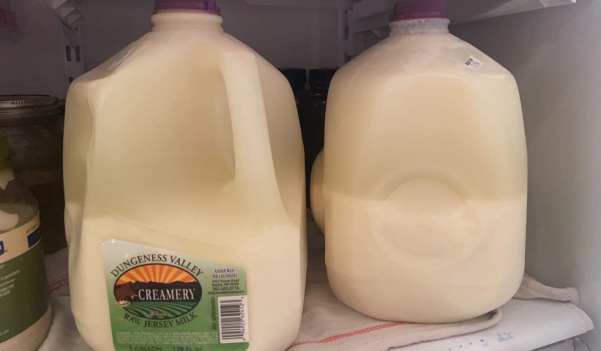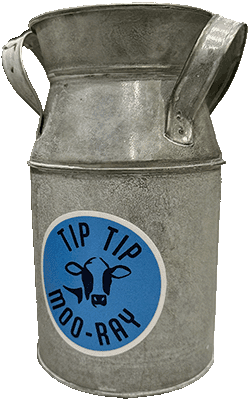What’s wrong with this picture? The milk is good and it comes from a great farm. It’s the freezing that affects raw milk this way.

What happened?
Something happened. Cream is supposed to float to the top. Instead, the cream and milk solids have sunk to the bottom of the gallon jug together. This is commonly experienced after freezing raw milk in an attempt to keep it long term without souring or clabbering.
Is freezing raw milk an issue?
Maybe, maybe not, depending on your expectation of the raw milk, but needless to say something has changed. It’s not as raw as it once was.
We can see that something has been denatured or damaged while freezing the milk. Research should be done on this, but good luck getting Science™ to do that.
Many people freeze their milk and are fine with it, you’re still getting plenty of good nutrition. Personally, I never freeze raw milk. I want to make sure I’m getting everything that raw milk has to offer and I live in a state where raw milk is readily available.
Let’s take a look at some solutions you may use to avoid freezing your raw milk.
Scenario 1: your retailer only carries frozen raw milk
I’ve seen a few cases in which small co-ops will buy milk and immediately freeze it. They do this because they don’t have enough daily customers, or enough customers who buy raw milk. They want to have raw milk in stock, but they also don’t want it to go to waste. Makes sense, but you can’t have never-frozen milk if it’s been frozen before you’re able to get it.
You can circumvent this process by speaking with them directly. Commit to buying the milk, have them stick it in the fridge instead, arrange to pick it up soon after they receive it. Even better if you can get on a schedule with them.
Scenario 2: farm is far away, can’t buy raw milk weekly
After a week in the fridge, the composition of your raw milk will change. That’s just how it goes. Based on a two-week schedule, you can do one or more of the following through the second week.
- Enjoy it sour/ clabbered (yes, people do this)
- Brew it into raw milk kefir ahead of time
- Not have raw milk
To slow aging, you can adjust your fridge temp just above freezing but lower than your normal temperature. If you’re going to make kefir, do it as soon as you get the milk.
Worth mentioning: you might be able to avoid all this by organizing some sort of collective effort for delivery. If you know someone else who also buys from this farm and lives near you, you can team up. Set a schedule so you pick up a shopping list one week, and switch off, or something like that.
Scenario 3: long winter dry spells
Less common now than it once was, winter dry spells may your fate. You’ve got access to a great farm who supplies you with delicious raw milk… but they dry out in the winter.
That’s a bummer, but you’ve still got options. First option is to accept that freezing is the only way you will have milk, and just go with that through your winter season. Not ideal, but you’re not in an ideal situation. It’s not a terrible option as you’ll only be doing so for that part of the year. Frozen milk may still be better than your options at the grocery store.
Second option is to do what our ancestors did, provision for the dry spell by transforming the milk. You might do a bit of both, but let’s get an overhead of this second option.
Raw milk long storage, the ancient way
So we’ve established that you’re not in an ideal situation, and you have to make due. You want to continue absorbing the benefits of raw dairy products over the course of months without access to fresh milk. This is where preparations like cheese and butter come into play.
Sour kefir
This may not be something you’re ready to jump on, but I’ve kept raw kefir in the fridge for months and consumed it without issue. It’ll separate, but you can blend or stir it back into stasis. It may become sharp by the end of it, sometimes very sharp, but some of us actually enjoy that. I’ve had kefir as sour as warhead candy and I loved it.
Raw cheese
Soft cheese is basically raw milk without the water and sugars, and it can keep in the fridge for months. Raw soft cheese is the easiest cheese to make. Allow the milk to coagulate into cheese, strain out the water, press out the remaining water, allow it to dry out a bit, then store in the fridge.
Raw butter
Butter is also a preparation that can sit in the fridge for months on end without going bad. There are plenty of ways to churn butter, you can find your preferred way to do it, just make sure to press out as much of the water as you can as the watery element is what causes spoilage in both butter and cheese.
Stockpiling, aka provisioning
You can build up a stockpile of enough butter and cheese over the preceding months ramping up to your dry spell to continue receiving the benefits of raw milk throughout. Buy a little bit extra each time you go to the store and build up gradually.
It’s worth doing some of each, as all these different forms come with their own unique characteristics and nutritional value.
Dive deeper into each preparation before you get started. Consult your favorite recipe book, mom blog, and/ or social media cheese-making groups, so you’ll be informed and can best implement these processes.




